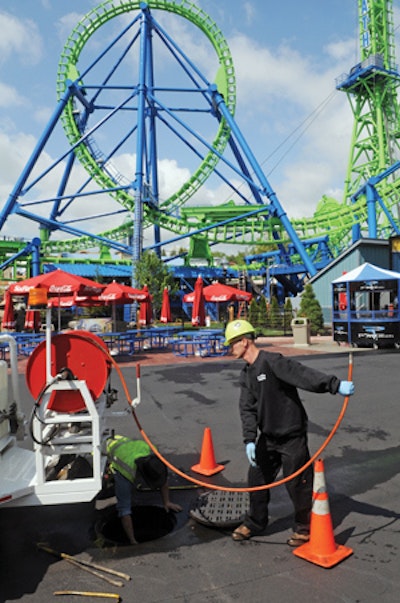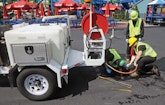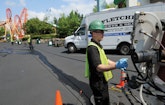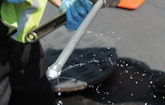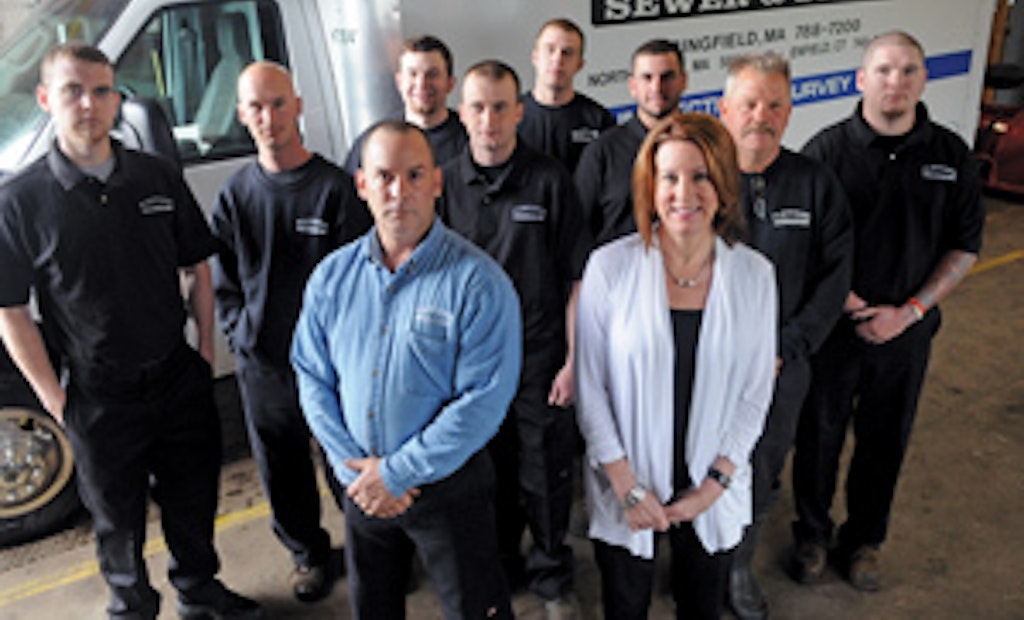
Interested in Cleaning?
Get Cleaning articles, news and videos right in your inbox! Sign up now.
Cleaning + Get AlertsThere are two defining periods in the overall operation of Fletcher Sewer & Drain Inc., according to company president Teri Marinello. The company has served western Massachusetts and parts of Connecticut for 27 years, but the first defining period began in 1996.
“That was the year we truly began to grow and to see the opportunities for expansion, all due to the one camera inspection unit we had at the time,” says Marinello. “We had received a phone call late one night, and a man’s wife had flushed her diamond ring down the toilet. We went out and saved the day. We found the ring in the lateral before the mainline sewer using our camera. That was the point where we really realized that we wanted to have a camera on each of our service vans. At that time we had three on the road.”
Marinello says finding the diamond opened their eyes to the importance of updated equipment and being in touch with the newest technology. “We have made that a part of our standard. We can say we are state of the art as we move forward.”
The second defining period for the company began in 2009 when they added a fully equipped CCTV van. Project manager Dave Lesure, who has been with Fletcher Sewer & Drain for seven years, likes to refer to 1996 as their “industrial revolution,” and 2009 as their “atomic age.” Before acquiring the new survey equipment, they had operated with push cameras but realized they needed more capability.
“We were getting requests from engineering companies and construction companies to provide a higher level of video inspection,” says Lesure. “We realized we wanted the camera truck and a state-of-the-art video system. We started looking around because we didn’t want to miss the boat with this technology.”
Lesure says he and Marinello worked together to decide on the software that would work with the RapidView IBAK North America camera truck they selected.
“We contacted a variety of software companies to see what they offered, the ease of operation, and cost,” he says. “We decided on PipeLogix Inc. as they provided what we and our customers wanted as far as survey reports, and it integrated into our system.”
He says they didn’t include mapping software because it was a function that would have been underutilized in their business.
“For every job, we hand a physical copy of the inspection to our client, and we retain a copy stored on our computer system hard drive,” Lesure says.
The Video Survey Department with Fletcher Sewer & Drain has been in operation for over three years, enabling the company to perform mainline sewer inspections for a wide range of projects and develop additional clients. Working as a subcontractor, they surveyed 5,000 feet of storm drain lines on a MassDOT – Highway Division project. Again, as a subcontractor, working along with the general contractor, they surveyed approximately 600 feet of 24- to 28-inch corrugated storm line that was on a railroad track.
Teri Marinello’s son, Joe, and Lesure are the video survey team, and both have had Pipeline Assessment Certification Program (PACP) training. One or the other is always on board if another technician is involved. Most often they function together.
Along the road to growth
While the video survey van may go out once or twice a week – sometimes for up to two weeks on a lengthy project – the trailers and portable jetters used for drain cleaning work are in service every day.
“We got into jetting in 1997 after my husband, Joe, and Jim Fletcher attended the Pumper & Cleaner Expo and saw that this was another explosion in technology,” says Teri. “It was a major investment for us. Joe was an excellent salesman, and he wrote letters to restaurants and apartment complexes pushing a preventive maintenance agenda. This really took off. In fact, we immediately hired one person as a full-time hydrojetter. Now, of course, all our technicians know how to use that equipment, as we have cross-training for all procedures.”
Preventive maintenance for supermarkets and restaurants is a good selling point, particularly in areas where grease builds up frequently. With the jetter they can go in and jet those grease lines to open them up, limiting the number of emergency service calls throughout the year.
The company’s jetting equipment includes a Harben 4018 DTK 300 E-180 trailer jetter, 300-gallon, 4,000 psi/18 gpm; a custom-built trailer jetter, 600-gallon capacity powered by a Kubota diesel engine with a 2,000 psi/39 gpm water pump by Giant Industries. Each trailer is equipped with multiple hose sizes, providing a wide variety of jetting capabilities. Portable jetters include a Mustang Model 1302, 1,300 psi/2.2 gpm; and a RIDGID KJ-1750 portable jetter, 1,750 psi/1.4 gpm.
Nozzles are from Enz USA Inc., Shamrock Pipe Tools Inc., RIDGID, and the Warthog by StoneAge Inc.
Their camera truck is a 2009 Ford E-350 16-foot box truck with separate office and operations areas that include two viewing sections to allow for instant review. The KRA65 system from RapidView IBAK North America includes the BE-3 controller and offers 650 feet of continuous inspection in 4- to 30-inch pipes. They use Muni-XS PACP software by PipeLogix Inc., and have multiple-format recording capability.
The company operates from a 4,500-square-foot facility in an industrial park. All technicians take their vans home at the end of the day, while the camera van and jetters are parked inside the building.
There are six service vans: four Chevrolet Express 3500 extended-wheel-base vans, and two Nissan NV 3500 HD cargo vans. Each carries a RIDGID standard SeeSnake color camera system and a RIDGID NaviTrack Scout Locator. They also have one RIDGID Mini SeeSnake Plus camera and other standard drain cleaning equipment.
The customer base is 50 percent residential and 50 percent commercial and municipal, including 20 or more property management and maintenance companies that represent major malls and their chain stores, and apartment complexes. Fletcher Sewer & Drain also does a lot of drain cleaning and jetting work for supermarkets. They hold a maintenance contract with one supermarket chain with 62 stores from western Massachusetts down to central Connecticut. This particular service takes place at night in order to avoid conflict with shoppers.
Current municipal work includes service for the City of Ludlow, but most nearby jurisdictions have their own equipment. The company also works with other plumbers, which represents up to 15 percent of their overall business, both in residential and commercial.
Engineering firms and general contractors come to Fletcher Sewer & Drain because their clients tend to be developers who want to have existing sewer lines televised to find out if there are problems, or to ascertain that the lines are acceptable.
Lines within buildings are primarily cast iron in western Massachusetts. In Connecticut there is some cast iron, but there is more plastic. Outside lines can be Orangeburg, clay, transite, reinforced concrete or PVC.
Structures can be new, but more are quite aged. One supermarket they service is a converted train depot that is 70 to 80 years old. Some homes in the area are 200 years old.
“Some of this plumbing is incredibly tricky,” says Lesure. “It can be paper thin cast iron stuff.”
Roots are a common problem in outside lines, but they also frequently run into ground swelling issues. They see egging where pressure has caused the line to lose its circular shape, and sometimes the entire line has eroded. Frost-thaw cycles also flatten some pipes and cause joints to separate.
Because they televise every line they clean, they have a visual of all issues and can pass that along to the customer, along with a recommendation as to what can be done. The customer then has an understanding of what they are dealing with and can determine if they want the line excavated and replaced.
The company repairs and will replace sewer laterals and sewer mains outside buildings, but they are not a licensed plumbing firm and do no inside repair or replacement. When there is a requirement for excavation, they bring in a subcontractor to handle the digging.
In the hands of the crew
Marinello says with emergency calls, it’s not always clear just what the issue is, but she can depend on the staff to deal with these situations.
“It starts at the dispatch desk,” she says. “Often a customer will say something that makes sense to them, but they’re not giving the information we need. It’s almost like translating a different language. By asking questions, the concerns can be passed on to the technicians, who will do their own troubleshooting when they get on site.”
Regular training and weekly meetings (Tool Box Talk) are helpful in solving concerns. They cover safety issues, equipment and basic feedback.
When it comes to hiring and training new technicians, they are not necessarily looking for experience, and they make it clear that a training period will last from a couple months up to a year.
“We also point out from the beginning that we consider a training period worthy of that investment, and that they will benefit in the long run,” says Marinello. “We want our men in the field to help the customer understand the problem, and further to have a pride of ownership in every job they perform.”
View from the top
Teri Marinello, who since 1989 has actively assisted in managing of the company, bookkeeping, accounting, executive decisions, observing work in the field and managing personnel, was well equipped to step into the role of president when unfortunate events came about.
Marinello says she is well known in the industry and enjoys her relationship with her employees as well as their wide range of customers.
“I’m fully aware of the conditions our technicians work in, and I do consider them to be my most important asset,” she says. “Our policy is that when we walk away from a home, or any other project, we know that the line is open and flowing, and what the problem was to begin with, and where we might need to go next for a resolution.”
